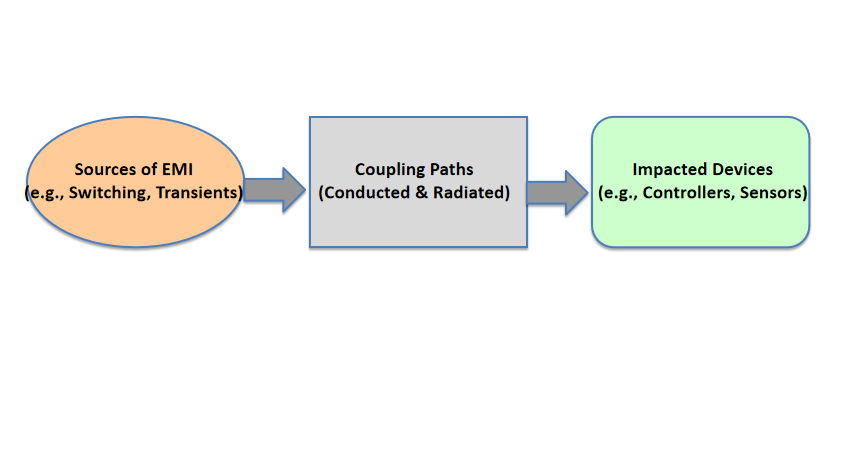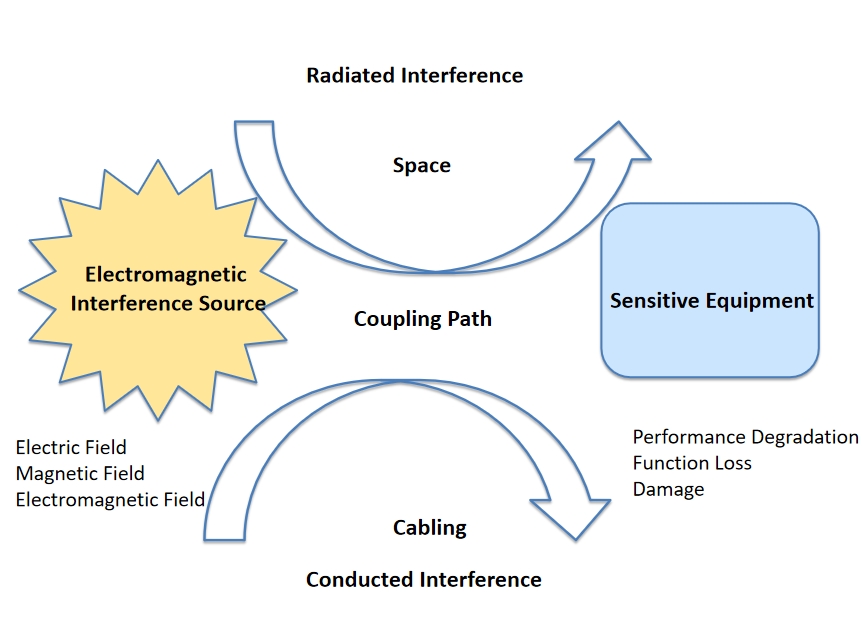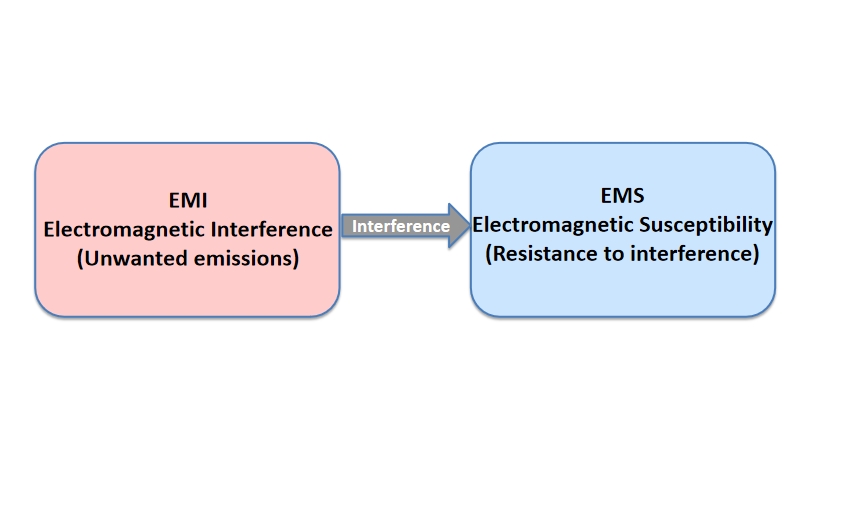Have you ever dealt with strange signal glitches or unexplained performance drops in your electronics? Chances are, electromagnetic interference (EMI) was at play—and your system lacked proper EMC protection. EMC, or Electromagnetic Compatibility, is a critical concept that ensures electronic devices can operate without interfering with each other or being disrupted by surrounding noise.
In today’s fast-moving world of power electronics and smart systems, EMC is no longer optional—it’s essential. As devices become smaller and faster, they also become more sensitive to interference. And nowhere is this more important than in transformers and power supplies, the heart of most electronic systems.
In this blog, I’ll walk you through what EMC really means, explain its two key components—EMI (Electromagnetic Interference) and EMS (Electromagnetic Susceptibility)—and show you how they impact transformer performance. Let’s uncover why EMC matters more than ever.
What Is EMC?
Electromagnetic Compatibility (EMC) refers to the ability of electrical and electronic systems to function properly in their electromagnetic environment without causing or being affected by electromagnetic interference (EMI). EMC ensures that devices can coexist without disrupting each other’s operations, making it a critical aspect of modern electrical engineering.
EMC includes two main aspects:
- EMI, or Electromagnetic Interference, is the unwanted signal that a device might release. This signal can interfere with the operation of nearby electronic equipment.
- EMS, or Electromagnetic Susceptibility, is the ability of a device to continue working properly when it is exposed to external electromagnetic noise.
In any power system or electronic design, especially those involving transformers and power supplies, EMC plays a critical role. It helps ensure safe, stable, and compliant performance even in challenging electrical environments.
EMC is essential for ensuring the smooth operation of electronic systems in complex electromagnetic environments. By addressing emissions, susceptibility, and coupling paths, engineers can design devices that are both reliable and compliant with regulatory standards.
How EMC Affects Transformers and Power Supplies
Electromagnetic Compatibility (EMC) is critical for ensuring transformers and power supplies operate reliably in their electromagnetic environment while minimizing interference with other devices. Below is a detailed analysis of how EMC impacts these components and the strategies to address these challenges.
1.Key EMC Challenges in Transformers and Power Supplies
A.Sources of EMI
Transformers and power supplies are inherently prone to generating electromagnetic interference (EMI) due to:
- High-frequency switching (e.g., in switch-mode power supplies), producing harmonics up to 100 MHz.
- Magnetic coupling in transformers, causing stray inductance and capacitance.
- Magnetic coupling in transformers, causing stray inductance and capacitance.
B.Coupling Paths
EMI propagates through:
- Conducted paths: Noise traveling via power lines or PCB traces (e.g., harmonics from rectifiers).
- Radiated paths: Magnetic fields from transformers or high-speed switching components acting as antennas
C.Impact of Poor EMC
- Device malfunction: EMI disrupts sensitive circuits like microcontrollers or communication modules.
- Regulatory non-compliance: Failure to meet standards like IEC 62041 can block market entry.
- Reduced efficiency: Noise increases power losses and heat generation
2.EMC Design Strategies
A.Filtering Techniques
| Component | Function |
| Common Mode Chokes | Suppress high-frequency noise on power/signal lines by introducing high impedance to common mode currents |
| X/Y Capacitors | Divert noise to ground (Y capacitors) or filter differential noise (X capacitors) |
| Ferrite Beads | Absorb high-frequency noise on cables or PCB traces |
B.Shielding and Layout Optimization
- Transformer shielding: Use toroidal cores or copper tape to contain magnetic flux leakage.
- PCB design: Minimize loop areas, use ground planes, and separate analog/digital sections.
- Enclosures: Metallic shielding blocks radiated EMI in sensitive applications like medical devices.
C.Compliance with Standards
- IEC 62041: Specifies emission and immunity requirements for transformers and power supplies (0 Hz–400 GHz).
- CISPR 32: Limits EMI emissions for multimedia equipment.
- Testing protocols: Conducted emissions (150 kHz–30 MHz) and radiated emissions (30 MHz–1 GHz) tests ensure compliance.
3.Modern Challenges and Solutions
A.Wide-Bandgap Semiconductors (SiC/GaN)
- Challenge: Faster switching increases EMI at higher frequencies (up to 100 MHz).
- Solution: Planar transformers and advanced snubber circuits reduce dv/dt and di/dt noise.
B.High-Power Applications
- Renewable energy systems: Solar inverters use multilayer filters to suppress grid-injected harmonics.
- Electric vehicles: Shielded CAN bus networks prevent EMI in battery management systems
C.AI-Driven EMC Simulation
Tools like Ansys HFSS predict EMI hotspots during design, reducing prototyping costs
4.Case Studies
| Application | EMC Issue | Solution |
| Industrial UPS | Conducted noise from H-bridge | Common mode chokes + X/Y capacitors |
| EV Chargers | Radiated EMI from DC-DC converters | Ferrite beads + shielded enclosures |
| Solar Inverters | Grid harmonics from PWM switching | Multistage LC filters |
5.Future Trends
- Integrated EMI filters: Embed passive components into ICs for compact designs.
- Adaptive filtering: Real-time noise cancellation using AI algorithms.
- Standard updates: Revised IEC 62041 guidelines for wide-bandgap devices.
EMC ensures transformers and power supplies function reliably without disrupting other systems. By addressing noise sources, coupling paths, and susceptibility through filtering, shielding, and compliance testing, engineers can mitigate EMI risks. As technologies like SiC/GaN and high-frequency converters evolve, advanced EMC strategies will remain pivotal for industrial, automotive, and renewable energy applications.

Why EMC Important in Transformers and Power Supplies
Why EMC Is Important in Transformers and Power Supplies
I often get asked why EMC matters so much when designing power systems or choosing transformers. The answer is simple. Without proper EMC control, your system might not work the way you expect it to. Even worse, it could interfere with other equipment or fail certification tests.
Transformers and power supplies are at the heart of most electronic systems. They handle energy conversion and distribution, which makes them both potential sources and targets of electromagnetic interference. If they are not built with EMC in mind, they can become weak points in your entire setup.
That is why I always recommend working with EMC-compliant components from the start. It helps ensure smoother performance, better signal integrity, and longer product life. At Unicreed, we take EMC seriously in every design. It is not just about passing tests. It is about giving you reliable solutions for real-world environments.
The Three Elements of EMC Issues
To truly understand how EMC works, I always tell my customers to look at it as a system of cause and effect. There are three key elements involved in every EMC issue, and each one plays a role in how interference spreads and how we can control it.
The first is the interference source. This is where the unwanted electromagnetic energy comes from. In many cases, it could be something like a switching power supply, a motor drive, or even a high-speed digital circuit.
The second is the coupling path. This is how the interference travels. It can move through wires, which we call conducted interference, or through the air, known as radiated interference.
The third is the sensitive receiver. This could be any nearby component or system that reacts to the interference and stops working as intended.
If you picture the image I shared earlier, it clearly shows how these three parts connect. You will see an EMI source, the transmission path, and the device that gets affected. Once you understand this, it becomes much easier to find the right EMC solution.
To truly understand how EMC works, I always tell my customers to look at it as a system of cause and effect. There are three key elements involved in every EMC issue, and each one plays a role in how interference spreads and how we can control it.
The first is the interference source. This is where the unwanted electromagnetic energy comes from. In many cases, it could be something like a switching power supply, a motor drive, or even a high-speed digital circuit.
The second is the coupling path. This is how the interference travels. It can move through wires, which we call conducted interference, or through the air, known as radiated interference.
The third is the sensitive receiver. This could be any nearby component or system that reacts to the interference and stops working as intended.
If you picture the image I shared earlier, it clearly shows how these three parts connect. You will see an EMI source, the transmission path, and the device that gets affected. Once you understand this, it becomes much easier to find the right EMC solution.

What are the Key EMC Measures for Transformers and Power Supplies?
When I help customers improve the EMC performance of their systems, we always focus on a few proven measures. These techniques are especially important in the design of transformers and power supplies, where even small changes can make a big difference.
First, we look at the physical layout. A clean PCB layout with proper spacing and grounding can reduce noise coupling. I always suggest keeping high current paths short and well separated from sensitive signal lines.
Second, we use filtering components. Common mode chokes, Y capacitors, and ferrite beads help block unwanted signals before they can reach other parts of the circuit. These are simple but effective ways to reduce EMI.
Third, we choose materials and construction methods that support good insulation and shielding. At Unicreed, we use quality cores, tightly wound coils, and potting materials that enhance EMC performance.
What Are the Common EMC Tests?
Common EMC Tests
Electromagnetic Compatibility (EMC) tests are crucial for ensuring that electronic devices operate without causing or being affected by electromagnetic interference (EMI). These tests are divided into two main categories: emissions testing and immunity testing. Below are some of the most common EMC tests:
Emissions Tests
These tests measure the electromagnetic energy emitted by a device, ensuring it does not exceed regulatory limits.
Radiated Emissions: Measure the electromagnetic fields emitted into the environment, typically using antennas in an anechoic chamber.
Conducted Emissions: Assess noise transmitted through power lines or cables, often using a Line Impedance Stabilization Network (LISN) or Artificial Mains Network (AMN).
Flicker Tests: Evaluate voltage fluctuations caused by a device, ensuring they do not exceed acceptable limits.
Harmonic Tests: Measure the harmonic current requirements of a device to prevent overheating and efficiency issues
Immunity Tests
These tests evaluate a device’s ability to withstand external electromagnetic interference without malfunctioning.
- Radiated RF Immunity: Assess a device’s resistance to electromagnetic fields, ensuring it functions correctly under exposure.
- Conducted Immunity: Test a device’s ability to resist conducted interference, such as electrical fast transients (EFT) or surge immunity.
- Electrostatic Discharge (ESD) Immunity: Evaluate a device’s resistance to static electricity discharges, which can occur through direct contact or air discharges.
- Magnetic Field Immunity: Measure a device’s ability to operate in the presence of magnetic fields, typically at network frequencies.
- Electrical Fast Transient (EFT) Immunity: Simulate electrical disturbances like those caused by switching devices, ensuring the device remains operational.
Standards and Testing Environments
EMC tests are conducted according to various international standards, such as those from IEC, CISPR, and ISO. Testing environments include open-area test sites (OATS), anechoic chambers, and specialized EMC test chambers like the Gigahertz Transverse Electromagnetic (GTEM) cell
EMC tests are essential for ensuring that electronic devices comply with regulatory standards and operate reliably in their electromagnetic environment. By performing these tests, manufacturers can identify and mitigate potential EMI issues, ensuring their products meet global safety and performance requirements.

Practical Applications
Electromagnetic Compatibility (EMC) ensures that electronic devices and systems can function reliably without causing or being affected by electromagnetic interference (EMI). Here are some practical applications of EMC across various industries:
1.Medical Devices
Application: EMC is critical in medical environments where devices like pacemakers, MRI machines, and patient monitors operate in close proximity.
Importance: Prevents EMI from disrupting life-saving equipment, ensuring accurate diagnostics and safe operation.
Example: Shielding and filtering in MRI machines to avoid interference with imaging signals.
2.Automotive Systems
Application: Ensures reliable operation of electronic control units (ECUs), sensors, and communication networks like CAN bus.
Importance: Protects vehicle electronics from EMI generated by high-power components such as electric motors.
Example: Common mode chokes and ferrite beads are used to suppress noise in electric vehicle charging systems.
3.Industrial Automation
Application: EMC is essential in environments with heavy machinery, motor drives, and programmable logic controllers (PLCs).
Importance: Prevents EMI from disrupting automation systems, ensuring operational efficiency.
Example: Use of filters and shielding to protect PLCs from conducted and radiated EMI.
4.Renewable Energy Systems
Application: Solar inverters, wind turbines, and energy storage systems require EMC to ensure efficient power conversion.
Importance: Suppresses harmonics injected into the grid and protects sensitive components from transient surges.
Example: Multistage filters in solar inverters to reduce conducted emissions.
5.Telecommunications
Application: EMC ensures stable operation of wireless communication devices such as smartphones, routers, and base stations.
Importance: Prevents signal degradation due to interference from nearby electronics.
Example: Shielding enclosures for base stations to block external EMI.
6.Aerospace and Defense
Application: Aircraft avionics, radar systems, and communication equipment must meet stringent EMC requirements.
Importance: Ensures safety-critical systems remain operational despite exposure to high levels of EMI.
Example: Use of advanced shielding materials in aircraft wiring to prevent radiated interference.
7.Consumer Electronics
Application: EMC compliance is necessary for everyday devices like TVs, laptops, and appliances.
Importance: Prevents interference between devices operating in close proximity.
Example: Conducted emissions testing for power adapters to ensure compliance with standards like CISPR32
Practical applications of EMC span across industries such as healthcare, automotive, industrial automation, renewable energy, telecommunications, aerospace, and consumer electronics. By addressing EMI through filtering, shielding, grounding, and compliance testing, engineers ensure that devices operate reliably while maintaining safety and performance standards.
Conclusion
To wrap things up, Electromagnetic Compatibility, or EMC, is the ability of electronic devices to operate as expected in their environment without causing or suffering from interference. For transformers and power supplies, EMC is not just important—it is essential. These components play a central role in energy distribution and signal integrity, making them highly sensitive to electromagnetic issues.
That is why I always recommend considering EMC at the very beginning of your design process. Addressing it early helps you avoid costly redesigns, failed compliance tests, or unexpected performance issues later on.
If you are looking for reliable transformer solutions that meet EMC requirements, I invite you to connect with us at Unicreed. We offer EMC-focused transformer products, tailored design support, and expert consultation to help bring your project to life. Feel free to contact me at sales@unicreed-transformer.com I am here to support your success.



